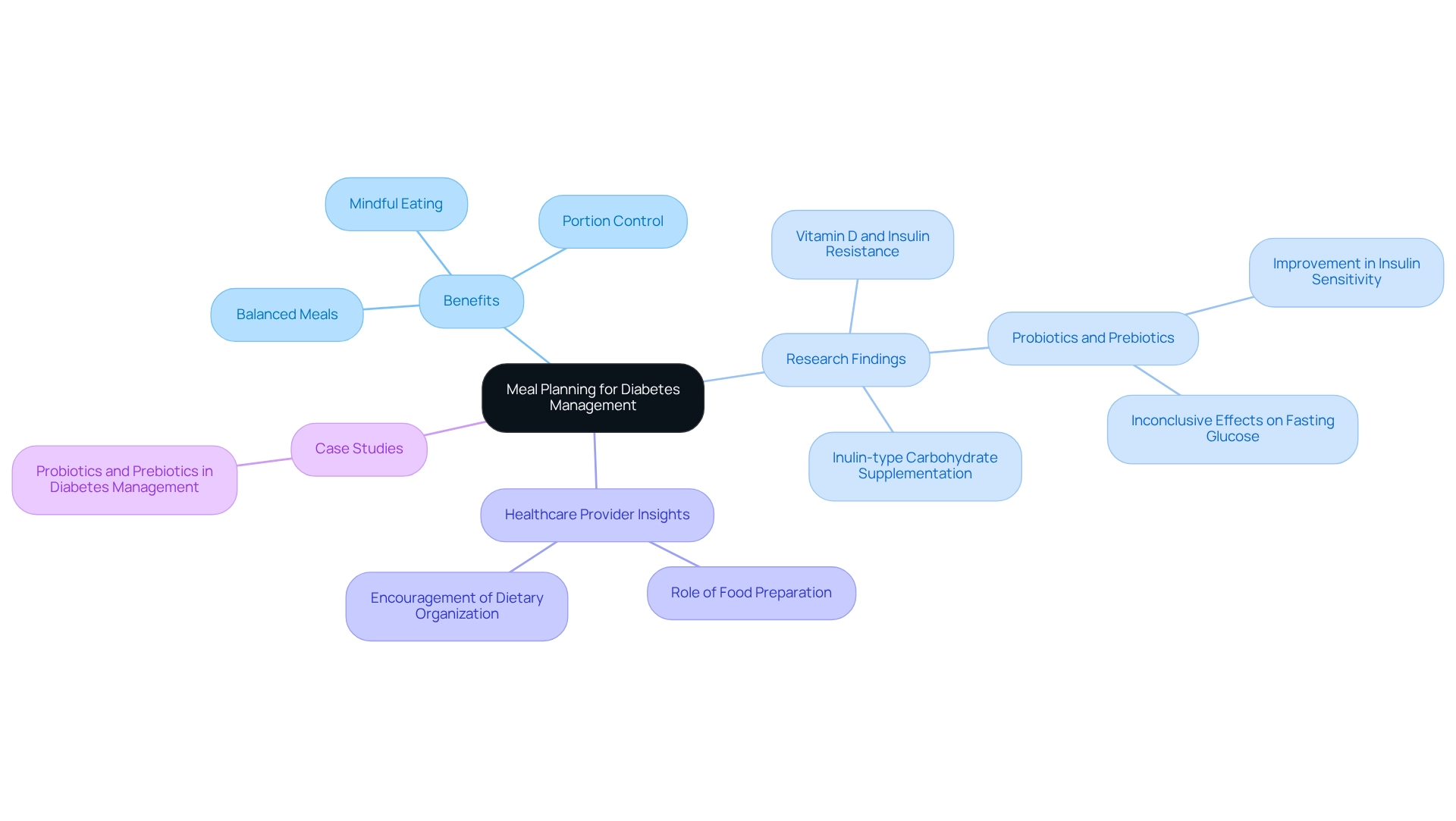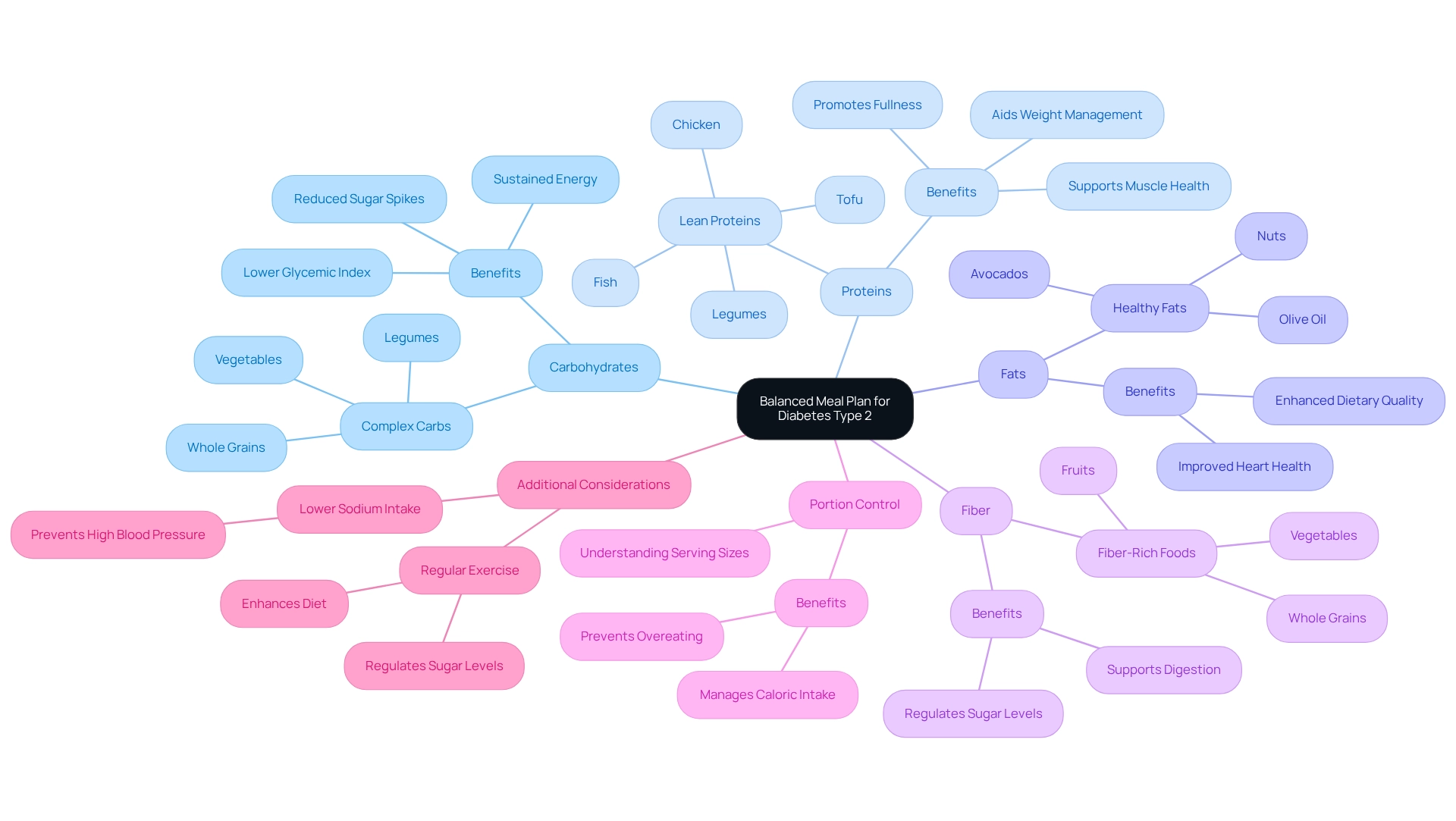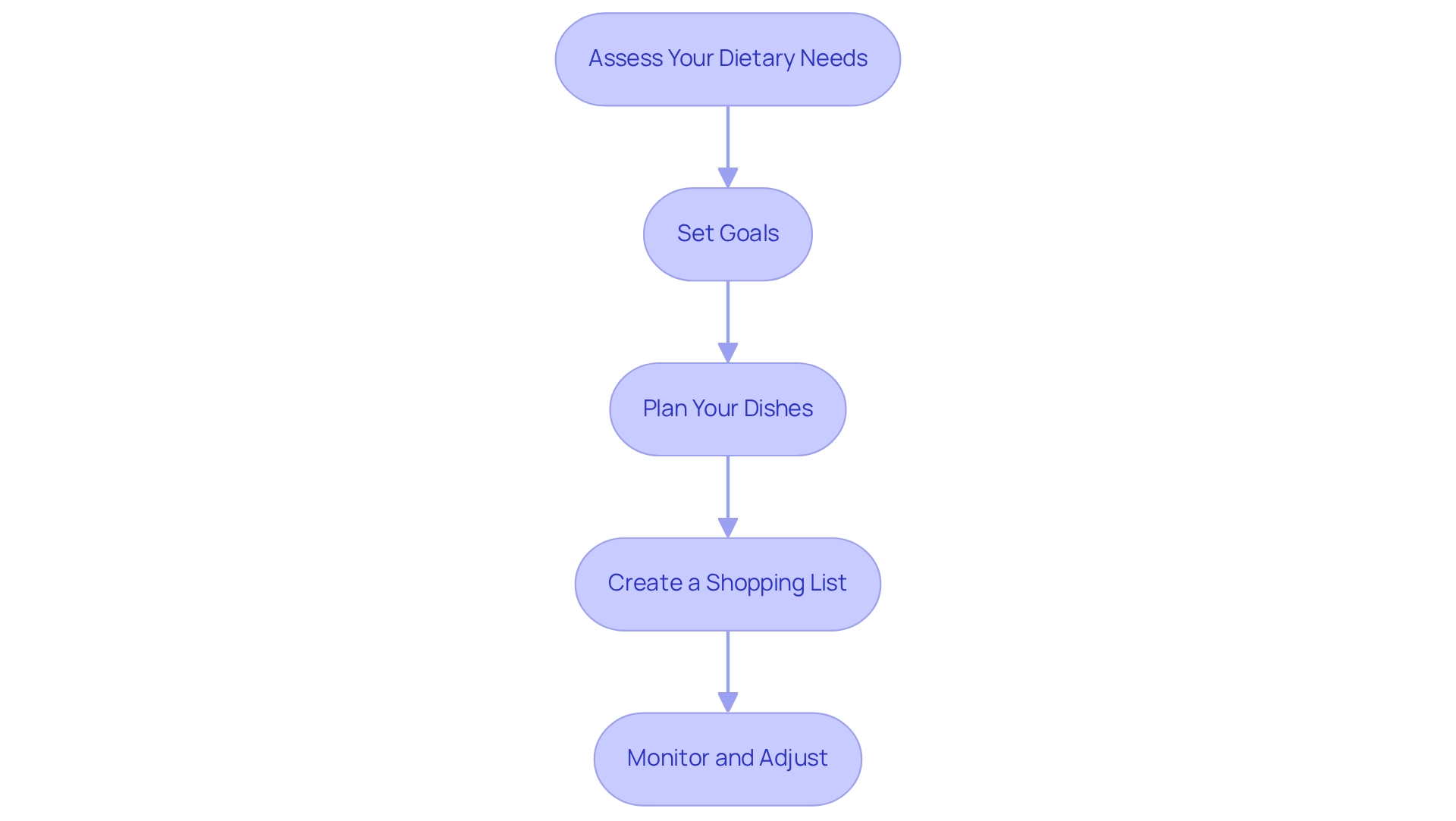Overview
This article presents a thoughtful four-step approach to creating a personalized meal plan for managing Type 2 Diabetes. It highlights the crucial role of dietary planning in stabilizing glucose levels and promoting overall health. By prioritizing complex carbohydrates, lean proteins, healthy fats, and fiber, you can develop a balanced meal plan that supports your journey.
Understanding the importance of meal planning can feel overwhelming, but you are not alone in this process. This article provides essential tools and resources designed to enhance your adherence to dietary goals. Remember, taking small steps can lead to significant changes in your health.
As you embark on this journey, consider how these strategies can fit into your daily life. Sharing your experiences with others can create a supportive community that understands your challenges and triumphs. Together, we can navigate this path toward better health.
Introduction
In the journey of managing Type 2 Diabetes, meal planning emerges as a vital ally, empowering you to take control of your dietary choices. This proactive approach not only helps in crafting balanced and nutritious meals but also plays a crucial role in stabilizing blood sugar levels, thereby preventing potential complications.
It's understandable to feel overwhelmed by these changes, but know that you are not alone. With the increasing recognition of its significance, healthcare professionals advocate for structured meal planning as a means to enhance overall health and well-being.
By understanding the essential components of a balanced meal plan and utilizing effective tools and resources, you can embark on a path toward improved health outcomes and a better quality of life.
Remember, we are here to support you every step of the way.
Understand the Importance of Meal Planning for Diabetes Management
Effective management of Type 2 Diabetes relies on food planning, particularly when eating with diabetes type 2. It empowers individuals to take charge of their dietary choices, ensuring that meals are both balanced and nutritious. By planning food in advance, you can prevent impulsive eating with diabetes type 2 and make healthier choices that meet your specific dietary needs. This proactive approach is crucial for stabilizing glucose levels, which is essential for eating with diabetes type 2 and helps avoid complications related to blood sugar issues.
At T2DSolutions, we understand the significance of organized dietary preparation in managing blood sugar. Engaging in dietary organization can improve blood sugar management and reduce insulin resistance when eating with diabetes type 2. Recent research highlights that high-dose vitamin D supplementation can lower insulin resistance, underscoring the importance of dietary management in diabetes care.
Healthcare providers emphasize the value of food preparation. Many support its role in encouraging portion control and mindful eating. A well-organized dietary plan for eating with diabetes type 2 not only aids in weight management but also fosters a deeper understanding of nutritional requirements, which is vital for long-term health.
Case studies illustrate the benefits of food preparation. For example, studies on probiotics and prebiotics suggest potential improvements in insulin sensitivity, indicating that dietary changes can enhance overall management of the condition. While the effects on fasting glucose and cholesterol levels remain inconclusive, the positive outcomes related to insulin resistance highlight the need for a thoughtful approach to diet.
In summary, dietary planning is a cornerstone of health management, particularly in the context of eating with diabetes type 2. It provides a pathway to healthier eating habits and improved glucose regulation. By prioritizing this practice and utilizing resources available at T2DSolutions, you're taking a significant step toward improving your quality of life and health outcomes. Remember, you're not alone in this journey; we are here to support you every step of the way.

Identify Key Components of a Balanced Meal Plan
A well-rounded dietary plan for eating with diabetes type 2 is crucial for managing glucose levels while providing sufficient nutrition and maintaining stable sugar levels. It's understandable to feel overwhelmed by the information, but focusing on key components can make a significant difference in your journey.
- Carbohydrates: Prioritize complex carbohydrates such as whole grains, legumes, and vegetables. These foods have a lower glycemic index, providing sustained energy and reducing sugar spikes. Remember, small changes can lead to big improvements.
- Proteins: Incorporate lean protein sources like chicken, fish, tofu, and legumes. These options not only support muscle health but also promote feelings of fullness, aiding in weight management. You're not alone in seeking balance; many find this approach helpful.
- Fats: Opt for healthy fats found in avocados, nuts, and olive oil. These fats contribute to improved heart health and can enhance overall dietary quality. It's all about nourishing your body with the right choices.
- Fiber: Ensure a high intake of fiber-rich foods, including fruits, vegetables, and whole grains. Fiber supports digestion and plays an essential role in regulating sugar levels, making it a vital part of any meal plan for those eating with diabetes type 2. You deserve to feel your best.
- Portion Control: Understanding serving sizes is critical for preventing overeating and managing caloric intake effectively. This awareness helps maintain a balanced diet while supporting weight management goals. Remember, every step counts.
Furthermore, lowering sodium consumption can assist in preventing and managing high arterial pressure, which is especially crucial for those with sugar-related conditions. Consistent exercise enhances a balanced diet and aids in regulating sugar levels efficiently, as highlighted by Mrs. Aiswarya Raj Kalyan, who stresses the significance of a comprehensive approach to diabetes care.
By focusing on these key components, individuals can create meals that suit their needs for eating with diabetes type 2, satisfying their hunger while aligning with their health objectives and ultimately enhancing their quality of life. For example, eating with diabetes type 2 can involve incorporating high-fiber carbohydrates, lean proteins, and healthy fats into breakfast to provide a nutritious start to the day while supporting blood sugar management. Recent research underscores that healthy eating habits are essential for those eating with diabetes type 2, significantly improving outcomes and reinforcing the importance of these dietary guidelines. We are here to support you every step of the way.

Create Your Personalized Meal Plan: Step-by-Step Guide
Creating a personalized meal plan for managing Type 2 Diabetes involves several essential steps that can truly make a difference in your journey:
-
Assess Your Dietary Needs: Begin by evaluating your nutritional requirements. Consider factors such as your age, weight, activity level, and any existing health conditions. It’s understandable to feel overwhelmed, but consulting with a healthcare provider or a registered dietitian can provide valuable insights tailored to your specific situation regarding eating with diabetes type 2.
-
Set Goals: Clearly define what you aim to achieve with your dietary plan. This could include objectives like weight loss, improved blood sugar control, enhanced energy levels, and strategies for eating with diabetes type 2. Remember, setting realistic and measurable goals is crucial for maintaining motivation and feeling accomplished along the way.
-
Plan Your Dishes: Choose recipes that include the essential elements of a balanced diet, emphasizing whole foods that are rich in nutrients. Aim for variety to keep your meals interesting and satisfying. Preparing dishes in advance can save time during hectic weekdays, making it simpler to adhere to your plan. For instance, the Portfolio Diet, which includes cholesterol-lowering foods, has shown to reduce LDL-C levels significantly. While it hasn’t been formally tested in diabetes populations, its components can be beneficial for those eating with diabetes type 2.
-
Create a Shopping List: Based on your dining plan, compile a comprehensive shopping list of necessary ingredients. This structured method helps you avoid spontaneous buys and ensures you have everything you need to prepare your dishes. You’re taking a proactive step toward better health!
-
Monitor and adjust your approach to eating with diabetes type 2 by consistently checking your blood sugar levels and being mindful of how you feel. It’s important to be open to making adjustments based on your experiences and feedback from your healthcare team. This iterative process is vital for optimizing your dietary approach and ensuring you feel your best.
Integrating a structured dietary planning approach is crucial for effective blood sugar control, especially when eating with diabetes type 2, as it also improves overall health. Research indicates that personalized meal plans are crucial for eating with diabetes type 2, as they can significantly enhance health outcomes and make it essential to tailor your approach to your unique needs. As Dr. John L. Sievenpiper states, "The objectives of nutrition therapy are to sustain or enhance quality of life and nutritional and physiological health; and to prevent and address both acute and long-term complications of the condition."
Furthermore, consider seeking out educational programs on managing blood sugar levels in your area for additional support. Remember, you’re not alone in this journey—T2DSolutions is here to assist you every step of the way.

Utilize Tools and Resources for Effective Meal Planning
To streamline your meal planning process, consider utilizing the following tools and resources that can make a significant difference in your journey:
-
Meal Planning Apps: Applications like MyFitnessPal and Lose It! are essential for monitoring food consumption, organizing dishes, and tracking nutritional values. Recent advancements have introduced tailored food organization features powered by AI, which enhance user experience and effectiveness in managing dietary needs. Remember, you're not alone in navigating these tools; they are here to support you.
-
Recipe Websites: Platforms such as EatingWell and the American Diabetes Association offer an abundance of recipes for eating with diabetes type 2, providing inspiration and direction for planning meals. These resources are particularly effective as they cater specifically to the nutritional needs of individuals who are eating with diabetes type 2. It's understandable to feel overwhelmed, but these recipes can help guide you toward healthier choices.
-
Grocery Delivery Services: Services like Instacart and Amazon Fresh can significantly reduce the time spent on grocery shopping by delivering items directly to your door. This convenience allows you to focus more on meal preparation and less on logistics. Imagine the relief of having your groceries brought to you, giving you more time to enjoy cooking.
-
Community Support Groups: Engaging with local or online support groups for individuals with blood sugar issues fosters a sense of community and provides encouragement. These groups often share recipes and tips for eating with diabetes type 2, which helps you navigate the challenges of managing diabetes through shared experiences. Remember, you are not alone in this journey; there are others who understand and are willing to support you.
By leveraging these tools and resources, you can enhance your meal planning experience, making it easier to adhere to your dietary goals and improve your overall health. Together, we can navigate this path toward better health and well-being.

Conclusion
Meal planning is a vital strategy in effectively managing Type 2 Diabetes. By taking charge of your dietary choices, you can create balanced, nutritious meals that help stabilize blood sugar levels and enhance your overall well-being. Understanding the components of a balanced meal—such as the right types of carbohydrates, proteins, fats, and fiber—is essential. Additionally, portion control plays a significant role in crafting a meal plan that supports your health and encourages mindful eating habits.
Creating a personalized meal plan begins with assessing your unique dietary needs and setting clear health goals. It's important to plan meals that include a variety of nutrient-rich foods. The step-by-step guide emphasizes preparation and adaptation, allowing for adjustments based on your experiences and feedback from healthcare professionals. Utilizing tools like meal planning apps, recipe websites, and community support groups can simplify this process, making it easier to maintain a healthy diet.
Ultimately, a structured approach to meal planning empowers you to take control of your health and improve your quality of life. By prioritizing this proactive strategy and leveraging available resources, you can make significant progress toward better health outcomes and a more fulfilling lifestyle. Embracing meal planning is not just about managing diabetes; it’s about cultivating a healthier relationship with food and making informed choices that benefit both your physical and emotional well-being. Remember, you're not alone in this journey; we are here to support you every step of the way.
Frequently Asked Questions
Why is meal planning important for managing Type 2 Diabetes?
Meal planning is crucial for managing Type 2 Diabetes as it empowers individuals to make balanced and nutritious dietary choices, helps prevent impulsive eating, and stabilizes glucose levels, which is essential for avoiding complications related to blood sugar issues.
How does dietary organization affect blood sugar management?
Engaging in dietary organization can improve blood sugar management and reduce insulin resistance, making it an essential practice for individuals with Type 2 Diabetes.
What role do healthcare providers play in food preparation for diabetes management?
Healthcare providers emphasize the importance of food preparation in encouraging portion control and mindful eating, which aids in weight management and fosters a better understanding of nutritional requirements.
What are some benefits of food preparation highlighted in case studies?
Case studies suggest that dietary changes, including the use of probiotics and prebiotics, can lead to improvements in insulin sensitivity, thereby enhancing overall management of Type 2 Diabetes.
What is the overall takeaway regarding dietary planning for individuals with Type 2 Diabetes?
Dietary planning is a cornerstone of health management for Type 2 Diabetes, providing a pathway to healthier eating habits and improved glucose regulation, which can significantly enhance quality of life and health outcomes.



